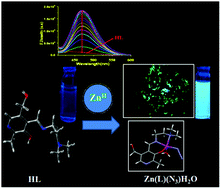Crystal structure, spectroscopic, DNA binding studies and DFT calculations of a Zn(ii) complex†
Abstract
Herein we report, a mononuclear, highly fluorescent zinc(II) complex Zn(L)(N3)(H2O) (1) that was prepared by an easy “one pot” method, in which the tridentate Schiff base ligand (E)-4-((2-(dimethylamino)ethylimino)methyl)-5-(hydroxymethyl)-2-methylpyridin-3-ol (HL) was generated in situ. The compound is characterized by various spectroscopic techniques, and its structure was determined by single crystal X-ray diffraction studies. DFT calculations were used to understand the electronic structures of the ligand and the complex, and TD-DFT calculations were performed to interpret the nature of the electronic transitions observed in their UV-vis spectra. In the complex, Zn(II) is found to be penta-coordinated with one azide ligand, an aqua ligand and a monoanionic tridentate N,N,O-donor ligand. In an aqueous methanol (1 : 9 by volume) solution, at the physiological pH (0.01 M Tris–HCl buffer, pH 7.4), compound 1 exhibits an intense greenish blue fluorescence (λex 390 nm, λem 462 nm), whose intensity is about 17-fold stronger than that of the free ligand. Compound 1 is found to show significant DNA binding activity. The pyridoxal appended tridentate ligand can be used for the bio-imaging of Zn(II).



 Please wait while we load your content...
Please wait while we load your content...